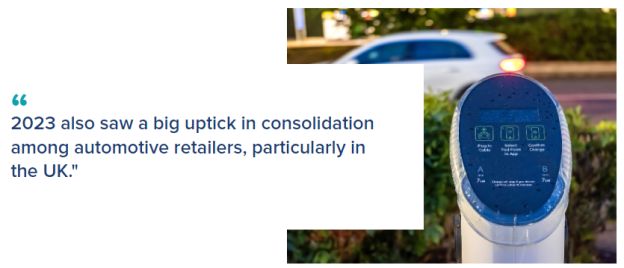M&A in the automotive sector has tended to focus on long-term collaborations and joint ventures at an operational level, rather than full scale corporate mergers – with honourable exceptions, such as the mergers to create Stellantis.
The sector is, however, undergoing an enormous transformation as it transitions to battery-powered and software-defined vehicles. The extensive capital requirements to fund this transformation naturally led to questions around the need for consolidation. This is becoming even more critical as original equipment manufacturers (OEMs) face constrained demand due to the economic climate and a real need to cut costs, particularly on electric vehicles (EVs), to drive sales volume.
Activity
Aside from the latest in a long line of speculative SPAC deals in the industry for VinFast, the Vietnamese EV maker, and the aborted US$2 billion deal for People's Republic of China (PRC) EV maker WM Motor, the largest deal in the sector in 2023 was Schaeffler's offer to acquire the shares it doesn't own in Vitesco Technologies, the listed EV and internal combustion engine (ICE) component maker, for €3.9 billion. Schaeffler's offer is indicative of the need for consolidation among automotive suppliers to enable them to reduce costs, as the size of their overall supply chain shrinks because of the EV transition and to retain relevance in the new EV supply chain.

We witnessed Middle Eastern sovereign wealth funds invest heavily in the new EV automotive economy. Notably Abu Dhabi investment vehicle, CYVN, made an additional US$2.2 billion capital injection into PRC EV maker and battery swapper Nio, giving CYVN an aggregate stake of 20% and a string of deals from Saudi Arabia's PIF. The PIF took a further US$1.8 billion stake in Lucid; raised its holding in Aston Martin to above 20%; signed a collaboration agreement for the development, manufacture and sale of vehicles with PRC EV maker Human Horizons (whose brand is HiPhi); and entered into a 70/30 JV with Hyundai for the development of a new automated EV and ICE vehicle manufacturing plant in Jeddah, Saudi Arabia.
This trend was not confined to the Middle East though – Stellantis effected a tie up with PRC EV maker Leapmotor, with the acquisition of a 21% equity stake for €1.4 billion, and in a similar deal VW acquired approximately 5% of PRC EV maker Xpeng for US$700 million. The Western OEMs hope to get access to new EV technologies which may help them to reduce costs and shorten their lead times in bringing new models to market; for the PRC OEMs, they hope that partnering with established Western majors will give them stronger brand recognition and facilitate their access to the European market.
2023 witnessed a continuation of a trend of OEMs investing directly in their supply chains, particularly seeking to build resilience and security of supply. Stellantis, VW (through its battery subsidiary, PowerCo), Glencore and others committed some US$1 billion in aggregate to London-listed SPAC ACG Electric Minerals, in part to fund its acquisition of two mines, producing nickel sulphide and copper, in Brazil. Stellantis also invested in lithium producer Controlled Thermal Resources and lithium-sulphur battery developer Lyten, providing other examples of OEMs' focusing on bringing some elements of battery development and production in-house. It remains to be seen how much this trend will continue in 2024 or whether OEMs will refocus on their core businesses, particularly as the recent price spikes in raw materials cool.
2023 also saw a big uptick in consolidation among automotive retailers, particularly in the UK. The North American giants entered the market in a big way, with Lithia's acquisition of the dealerships of both Jardine Motors for a reported £300 million and (following a competitive situation with Auto Nation and Hedin and Penske) Pendragon for £397 million and Alpha Auto acquiring Lookers for £504 million.
Outlook for 2024
Looking ahead to 2024, the expected flat overall demand for vehicles, along with the anticipated deceleration of the growth in EV sales, will take a toll on margins and place increased costs pressures on OEMs and suppliers. This is likely to result in an increased focus on both consolidation and collaborations.
Two key areas expected to witness this trend are PRC EV OEMs, as China manages excess domestic supply by driving consolidation and potentially the small-car EV market, as European OEMs in particular look to deliver the 'holy grail' of affordable EVs at acceptable margins in the face of considerable competition from the PRC OEMs.
The used car market, which has been buoyant post-Covid, is now facing some real near-term challenges, particularly due to low resale values of EVs, and this is likely to be a further area for M&A, potentially including some distressed M&A among recent market entrants.
To view the full article, click here.
The content of this article is intended to provide a general guide to the subject matter. Specialist advice should be sought about your specific circumstances.




